Post-2015 global development and South-South cooperation
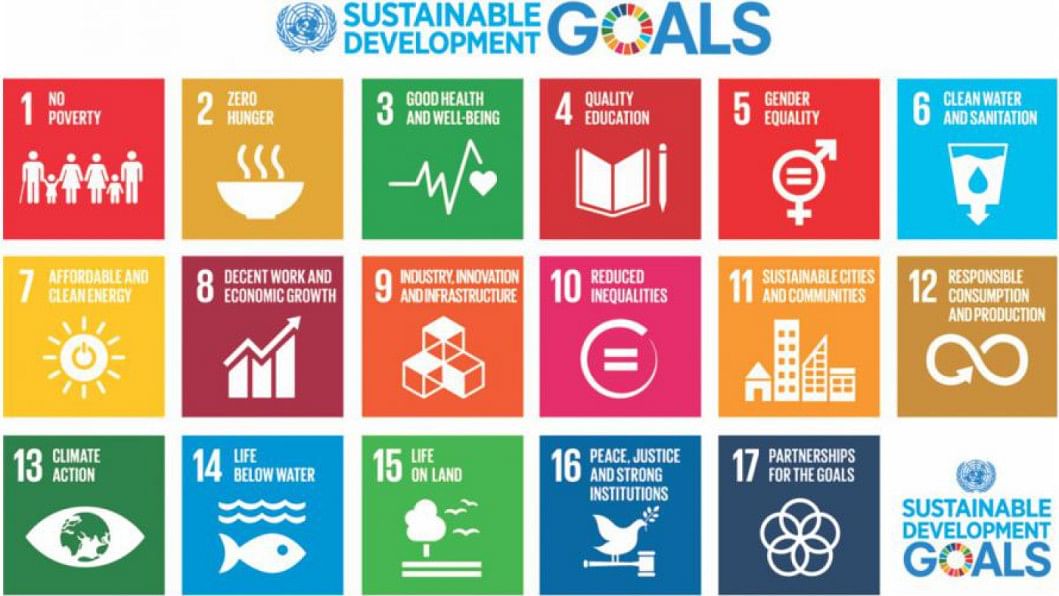
There is an increasing awareness to enhance South-South cooperation among the least developed and developing countries to achieve sustainable development and promote faster economic growth with equity. UN adopted eight Millennium Development Goals (MDGs) with 21 targets and 60 indicators for the period 1990-2015. Several countries are evaluating their respective performances. In September 2015 the UN adopted the post-2015 development agenda which is incorporated in Sustainable Development Goals (SDGs) to be achieved by 2030. The 17 goals and 169 targets of SDGs have to be achieved in the context of the complex relationship between the state and the market within the economy and the other countries in both hemispheres.
The heads of states and governments and high representatives, who gathered in Addis Ababa in Ethiopia in July 2015, reaffirmed that a global framework for financing development in the poor countries has to be formulated with strong political commitment. The South-South and Triangular cooperation is needed to encourage global partnership and solidarity to transform the conditions of the Least Developed Countries (LDCs), Landlocked Developing Countries (LLDCs), and Small Island Developing States (SIDS).
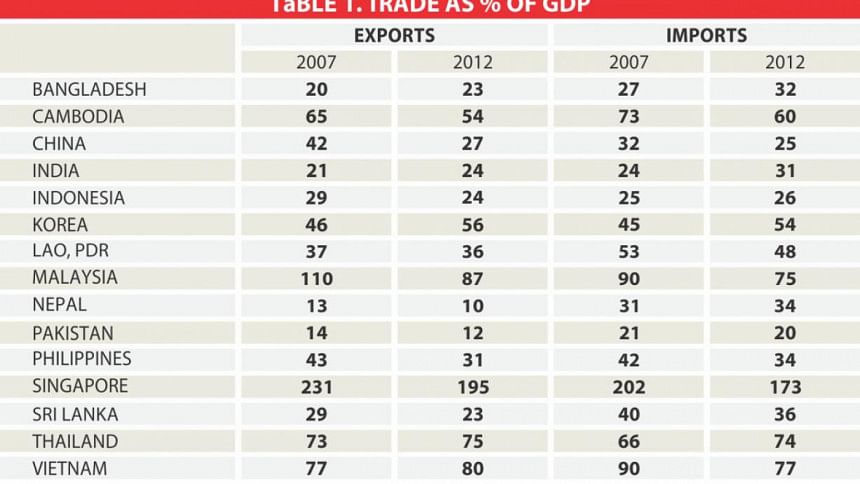
A vast majority of the world's poor live in Asia. A substantial amount of poor people also live in pacific island nations termed as SIDS. The emergence of globalisation has increased the openness of the world economy, which has resulted in greater cooperation among nations, donors, international financial institutions, multinational corporations, private entrepreneurs and non-government organisations. The countries, however, have not benefited uniformly; some even suffered negative "backwash effect" of global development. The countries of the south are specifically lagging behind, except few big ones like China, India, Brazil, and South Africa.
The status of LDCs applied to 48 countries according to the United Nations with some categorised into LLDCs and SIDS - 34 countries in Africa, nine in Asia, four in Oceania and one in the Americas. Since the LDC category was initiated, only four countries have graduated to developing country status. The first country to graduate from LDC status was Botswana in 1994. The second was Cape Verde, in 2007. Maldives graduated to developing country status on 1 January 2011, while Samoa graduated in 2014. It is anticipated that Equatorial Guinea and Vanuatu will be the next countries to be promoted from LDC status. At the UN's fourth conference on LDCs held in May 2011, delegates endorsed a goal targeting the promotion of at least half the current LDCs within the next ten years.
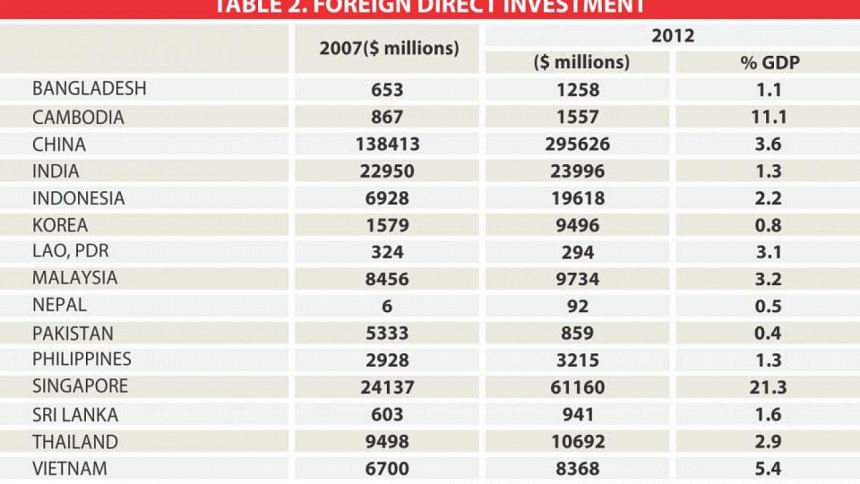
There are three countries which presently meet the criterion for LDC status, but have declined to be included in the index, questioning the validity or accuracy of the UN data: Ghana, Papua New Guinea, and Zimbabwe.
The post-2015 agenda should include some explicit accountability mechanisms for the relevant stakeholders. Within the agenda, specific goals should form part of a conceptual framework for development of the post-2015 period. These require considerable thought and appropriate responses which meet the political and technical needs of the multiple actors in global development.
Channels of cooperation
In the context of globalisation, some of the major challenges of cooperation are trade, foreign direct investment, credit flows, equity flows, and sale of bonds in the international capital markets. The important field of cooperation amongst Asian countries is exports and imports. The protagonists of development argue in favour of trade rather than aid, because experiences of aid from developed countries and international organisations have not been very encouraging, especially in achieving equitable development and poverty eradication. The performances of Asian countries have been shown in Table 1, 2, 3 and 4, which depict the situation of some developing countries in the fields of trade and development. The tables give a mixed picture. In Table 1, ten countries suffer a decline in exports as proportion of GDP in 2012 compared to 2007. There were modest increases in some countries including Bangladesh. Only the republic of Korea achieved significant increases in exports. In terms of imports six countries saw increases including Bangladesh, while nine countries suffered decline in imports. All countries except Lao PDR and Pakistan witnessed considerable increase in FDI in absolute value (Table 2). Table 3 shows as many as eight economies, including the major ones (China and India), achieving lower growth rates every year during the period 2011-2014, compared to the periods before the global financial crisis.
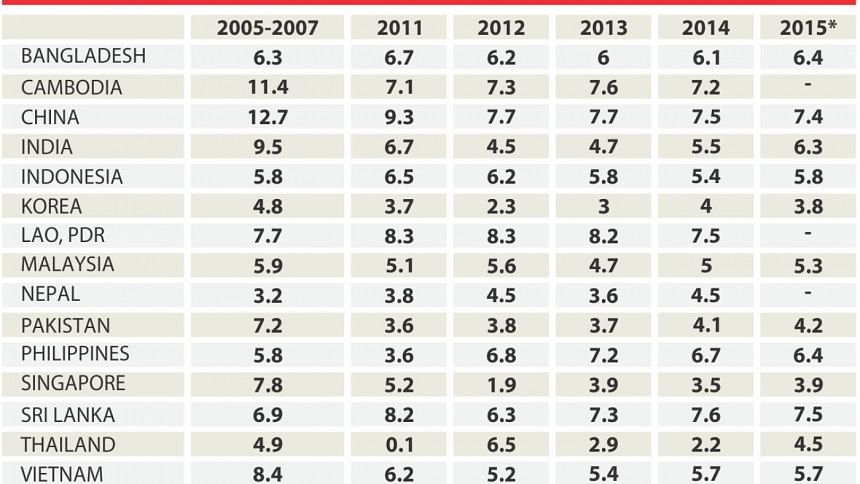
The major challenge faced by the developing countries is enhancing exports. Despite increase in trade in these countries the major destinations of exports are developed countries. In the context of low growth of the developed countries, the challenges of the developing countries are to increase trade among these countries and improve their growth performances. The flow of FDI from the developed countries may suffer a setback because of slow recovery of these countries from the global crisis and from the present turmoil in the financial sector, especially in Europe. The situation analysed here points to the need for greater South-South (SS) cooperation to enhance the development pace of the countries in the South.
Trade and investment policies play a crucial role in improving the prospects of LDCs taking advantage of globalisation and free trade. The countries of Asia-Pacific can derive huge benefits by mitigating their development disadvantages arising from small domestic markets, insufficient capital, and lack of efficiency in meeting international standards. During the past three decades, global value chains (GVCs) have played a dominant role in globalisation. GVC refers to a full range of cross-border, value-added business activities that are required to bring a product or service from conception, design, sourcing raw materials and intermediate input stages, to production, marketing, distribution and supplying to final consumers. Table 4 gives a picture of GVC in various developing countries. GVC participation rate defined by UNCTAD, refers to the extent to which a country's exports incorporate inputs with foreign value added (the upstream component), and the extent to which its exports contribute value added to other countries' exports (the downstream component).
Although the opportunities for GVC differ among these countries, they have some common disadvantages arising from small domestic markets and being less connected to regional markets and already developed production networks. According to the survey by OECD-WTO (2013), of the main obstacles that LDCs face in connecting to value chains, the foremost issue for more than half of domestic firms was inadequate infrastructure, followed by access to trade finance and compliance with technical standards.
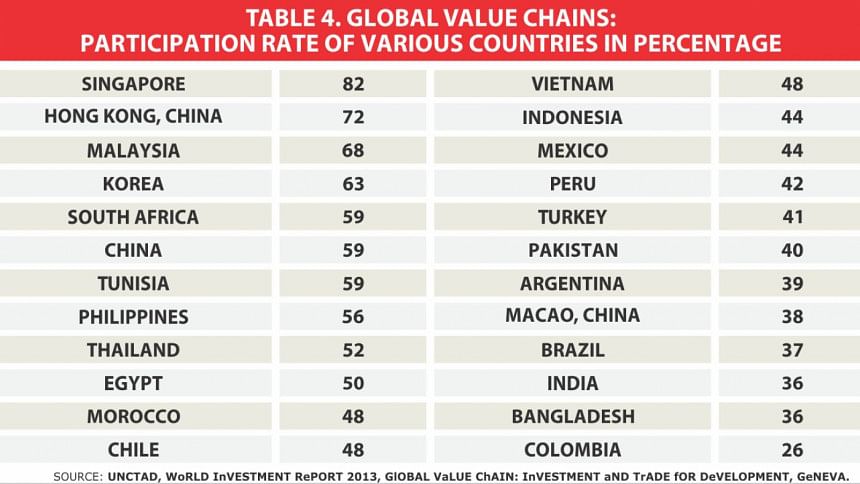
Removing those constraints will require massive investment for infrastructure development, reforms in educational and skill development systems, and provision of financial and technical assistance to small and medium enterprises (SMEs). Given the limited availability of capital and technical capacity in LDCs, financial and technical assistance from partner countries through "Aid for Trade" programmes, knowledge and technology transfers from lead firm of GVCs, and support from international organisations could play an important role.
Areas for action
To promote South-South (SS) cooperation the following areas should be given priorities:
1. Domestic resource mobilisation: Broadening tax bases, enhancing efficiency of the tax collecting authority, ensuring transparency, reducing discretionary power of tax officials. However, the strategy for domestic financing should be determined by the national governments. It should be pointed out that domestic resource mobilisation should not be taken as the pretext by the developing countries to reduce the relevance of official development assistance (ODA).
2. Strengthening regulatory regime and creating enabling environment for private sector investment including FDI: Laws related to land registration, contract enforcement to be made more relevant in the present context.
3. Strengthening the financial sector: Banks, non-bank financial institutions, insurance companies, capital market, should promote private sector investment, financial inclusion and gender equality.
4. Roles of policies: Along with fiscal and monetary policies, others like industrial, export, and financial inclusion policies that hold out the promise of ensuring sustainable and inclusive growth should be introduced by the respective government.
5. Stronger and better coordinated South-South cooperation in dealing with security issues has the potential to dramatically reduce international and civil conflicts, especially if drug trafficking and the global black market are collectively targeted for elimination.
6. South-South cooperation that aims to address humanitarian and social ills in Latin America and the Caribbean may be emulated to accelerate economic growth pursued with prudential measures to reduce inequalities, prevent social unrest and promote social cohesion.
7. As individual organisations of the United Nations system adopt strategic approaches to South-South cooperation in their policies and programmes, additional measures should be taken enabling agencies with similar expertise to pool or systematise their support to efforts of developing countries in priority areas such as the enhancement of productive capacities and the establishment of regional and global value chains that are essential to job creation and poverty eradication.
8. The most radical implications of information and communications technologies have not been realised yet, especially in enabling new financing, management and marketing arrangements that will render obsolete the hierarchical, top-down organisation of corporations. The ability to target niche markets cheaply will make artisanal and/or rural production competitive if the capacity to use off-grid renewable energy and other affordable technologies is better utilised for small-scale, high-quality industrial production in rural areas across the South.
9. The numerous contributions of the private sector and civil society to South-South cooperation should be better harnessed through stronger public-private partnerships that are systematically forged to address priority development needs through investments in science, technology and innovation as well as in other fields where non-state actors have high levels of expertise and resources.
10. The export sector of developing countries can increasingly participate in GVCs which will spread benefits within and across countries. Programmes for increasing GVCs can be tied with post-2015 SDGs.
Conclusion
The post-2015 development agenda for less developed countries needs to recognise the complex relationship between the state and the market, the nature of which is mostly complementary. Moreover, it is important to recognise the changing role of both state and market in the context of time specific country situation and the need to adapt. Countries that experienced success in the past brought the right blend of the roles of the state and the market especially in ensuring investments in infrastructure and social sectors and promoting employment-creating and inclusive growth and development. There should be a clear message that achieving the MDGs and delivering on the post-2015 SDG agenda is not optional, since the agenda involves an essential investment for a safer, more humane and prosperous world. The goals are not just an "aid obligation" but the basis for political and economic strategies that will benefit all the world's citizens, and not just the least fortunate.
The writer is Former Governor, Bangladesh Bank and Professor, BRAC University.

 For all latest news, follow The Daily Star's Google News channel.
For all latest news, follow The Daily Star's Google News channel. 



Comments